Porcelain Insulator News
by Elton Gish
Reprinted from "Crown Jewels of the Wire", March 1994, page 20
The text discussing the two photographs on page 15 of the January 1994 issue
of CJ was inadvertently omitted in the last "Porcelain Insulator News".
Our apologies to Dave Wysoski who submitted the photographs. As you can see,
this insulator appears to be the porcelain version of the glass Cochrane bells,
which also has a solid wood core. Dave said that they were found in a river in
north central Montana. He obtained them in a trade about 20 years ago. They must
have been laying in the river for a long time, because they had a lot of white
scale covering them. Much of the hard scale is still on the underside of each
bell, which Dave said is near impossible to remove. The string of eight bells is
about 30 inches long. Either Dave or I would appreciate hearing from other
collectors who have porcelain Cochrane bells. These must be rather rare.
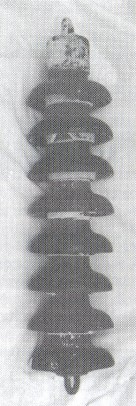
Porcelain Cochrane Bells?
The
only information that I could find was a similar "patented" strain
insulator in Ohio Brass catalogs from 1916 to the 1920' s, which was used for
river crossings. It, too, had a solid wood core, but the bottom of the bells were not all facing in the same direction.
In the Ohio Brass version, two bells on each end (4 bells in all) were facing toward the center of the string.
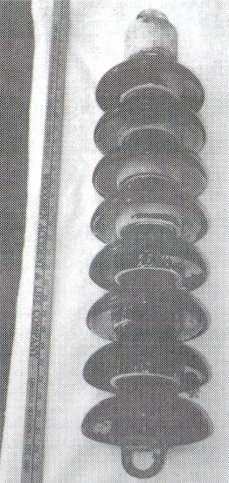
We have added several
new U-numbers to Jack Tod's U-Chart since we published the "1992
Supplement" to Jack's Porcelain Insulator Guide Book. As a reminder, the
"1992 Supplement" with 30 new U-styles is still available from me for
$1 and a long SASE.
Wesley Tucker first reported this new style of distribution
insulator in July 1991. I resisted assigning it a new U-number until Fred Collier found one with the incuse marking
"COOK". He said that he obtained it from Jeff Hogan. It is different
than any in the U-Chart since the wire groove is so narrow. This new style
has been assigned U-292B.

U-292B
Very few insulators have been found with the "COOK" marking. The
Cook Porcelain Insulator Corp. factory was in Byesville, Ohio. They began making
wet process porcelain insulators in the early 1920' s and were out of business
sometime in the early 1930's. Cook catalogs from June 1926 and March 1929
carried a rather complete line of insulators, which included three unusual
styles of multipart insulators. These were characterized by downward arcing top
cable grooves and upward arcing tie-wire grooves and can be seen in the drawing
for M-3420. We discussed the Cook patent for these features in my book Multipart
Porcelain Insulators. U-292B was not shown in either Cook catalog. However, one
insulator identical to U-292B with the exception of a 1- inch wire groove was
shown in the 1929 catalog. It would have been easy to change trimmer blades to produce this basic
style with a smaller wire groove for a special order.
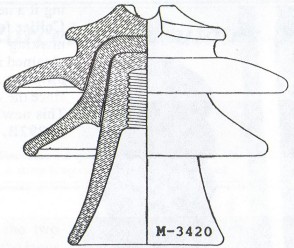
12 - 10 - 6.5 x 10
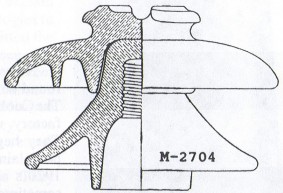
10 - 8.5 - 3.5 x 7
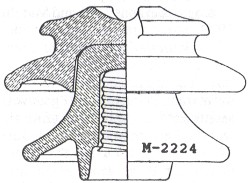
7 - 6 - 2.5 x 5
David Dahle reported an insulator U-460 with the "COOK" marking.
Several other styles of Cook unipart insulators can be found, but they are quite
uncommon.
Only three Cook multipart insulator styles have been reported. Jeff Kaminski
reported a marked M-2224 and Barry Conolly reported a marked M-2704. The M-2704 has a very unusual glaze in that it has
pumpkin-colored specs scattered throughout. Bill Rohde has reported an unmarked
M-3420. This specimen can be easily attributed to
Cook because of the arcing cable-top and tiewire grooves.
The original drawing
for U-922 was taken from the 1912 Thomas catalog, but a specimen of that style
was not reported until 1989. That specimen did not match the Thomas drawing with
respect to the glazewelded inner skirt. The specimen had a bell-shaped inner skirt, so Jack Tod redrew U-922 to match the
specimen. All seemed well calling this unmarked specimen a Thomas item. However,
as we became more aware of the characteristics of insulators made by the Lima
Insulator Co. from 1904 to 1908, it became apparent that the handful of U-922
specimens may indeed be Lima products.
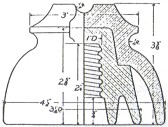
Original U-922 from 1912 Thomas catalog |
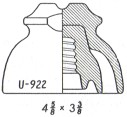
U-922 |
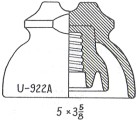
U-922A |
Bob Stahr found two styles similar to U-922, but they are 1/2 inch larger in
diameter. I have assigned this obviously new style U-922A. Note, too, that the
two petticoats of the glaze welded inner skirt are not flush with the outer
skirt, and that it is bell-shaped just like U-922. Yes, the glaze and pinhole
match the characteristics of Lima insulators.
I reprinted the only known example
of a Lima catalog a little more than a year ago (copies of this 32 page catalog
are still available from me). To further confirm our conclusion that both U-922 and U-922A are Lima products, note the
illustrations reproduced here from that catalog where each style exhibits the
bell-shaped glazewelded inner skirt. No. 18 is U-922 and the No. 20 is U-922A.
There is yet one more of this basic style to be discovered. Lima No. 241 is six
inches in diameter and No. 281 is seven inches in diameter. If specimens of
these insulators can be found, they will be U-922B and U-922C. Please check your
collection and keep a sharp eye out for these glazeweld styles.
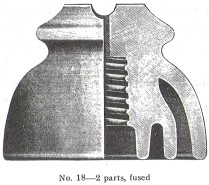
U-922 (11 Kv) from Lima catalog (4-1/2" x 3-3/8") |
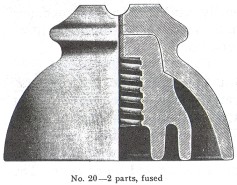
U-922A (15 Kv) from Lima catalog (5" x 3-1/2") |
|
"LIMA PORCELAIN"
|
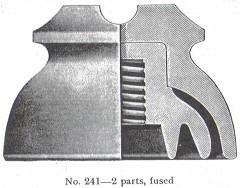
No. 241 (18 Kv) 6" x 4" |
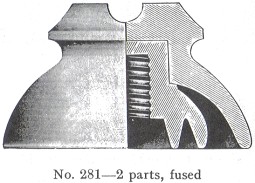
No. 281 (26 Kv) 7" x 4" |
These two styles shown in the Lima catalog
are larger versions of
U-922 and U-922A, but no specimens have been reported.
| CJ HISTORY: A Porcelain Question and Answer column by Jack H. Tod
originated in November 1971. Elton Gish has edited Porcelain Insulator News has
since June 1984. |
| 